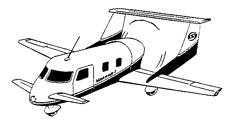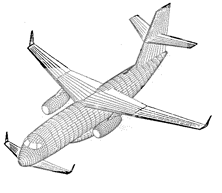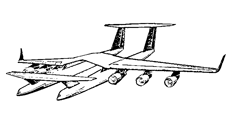

- Documentation
- Table of contents
- AKC
- Introduction
- Airframe Creation
- Technological Problems
- Experimental plant
- Building plant
- Conf. Development
- Aerodynamic Designing
- Algorithms of control
- Guidance & control
- Stand for training
- Training center
- Horizontal flight tests
- Crew on board
- Auto Landing complex
- Structure
- Payload bay
- Metallic material
- Non metallic material
- Non metallic material
- Cabin assembly
- Thermal designing
- Thermal protection
- Heat protection
- Quartz fibre
- Computer designing
- Gas's dynamic
- Strength
- Basic direction
- Tech. preparation
- Technical diagnostics
- Methods & means
- Radio nav. support
- Information & controls
- Control of onboard equ.
- Electric power dist.
- Electromagnetic
- Antennas installation
- Auxiliary power unit
- Hydraulic system
- Cabin
- Safety
- Air transportation
- Automatic landing
- Exp. working out
- Return to space
- SPIRAL
- Analysis of concept
- Horizontal take-off
- BOR-4 & BOR-5
- MAKS multipurpose
- MAKS-D
- Thermal design
- Gas & thermal design
- Wing deflection
- Flight performance
- Maks structure
- Metal materials
- Advanced non metallic
- Information provision
- Onboard starting comp.
- Onboard control comp.
- Control organization
- Aerospace systems
- Economic investigations
- Triplane aircraft
- Technical inventions
- Scientific potential
- Triumph and tragedy
- Birds of a Feather?
- TsAGI wind tunnel
- Bibliography
| -The Mriya is destroyed. |
| -Shipping of Buran-KS to Sotchi. |
| -Antonov is no more. |
| -Buran is now a museum. |
| -New pictures of the blogger Ralph Mirebs. |
From SPIRAL to MAKS
The Tri-plane Aircraft as the Means of the MAKS Efficiency Improvement
Dr. Lozino-Lozinsky G.E.
The perspectives of the MAKS performance improvement resulted from realization of the HERACLES twin-fuselage subsonic aircraft designed under the tri-plane scheme are considered. This plane at the AN-225 plane size will have lift capacity up to 450 ton and in case of the application as the Carrier-Plane for the MAKS system will allow to expand essentially a range of the payload mass injected into the Earth orbit. Effective application of the MAKS-M fully reusable system is thus possible economically. The HERACLES aircraft can be also used for the air transportation on the external brackets of the various purpose bulky cargoes.
The characteristics of the two-stage aerospace systems (ASS) in most cases depend on carrier-plane used. The hypersonic carrier-plane with maximum Mach number M = 6 was proposed for the SPIRAL system. The An-225 subsonic plane, biggest in the world, was used in the project of the multipurpose aerospace system (MAKS) as carrier-plane. The An-124 plane could use in other projects of ASS with lighter second stage. That’s why, considering prospects of aerospace systems development, we understand their dependence from development of subsonic and hypersonic aviation.
NPO MOLNIYA designed the project of the HERACLES subsonic transport plane with 900-tons maximum take-off mass and lift capacity up to 450 tons. The task to provide development of such plane using the existing production capacity of aviation and metallurgical industries was raised. At that, dimensions of developed plane couldn’t exceed the AN-225 plane’s dimensions determined by width spacing of assembly shops of such factories as the Ulyanovsky or Voroneshsky aviation plants. Working out of different versions showed that raised problem could be solved on the base of triplane aerodynamic scheme where 20% of lift capacity is created by forward horizontal aerodynamic surface.
The Major Advantages of the Tri-plane Scheme
Since 1990 NPO MOLNIYA has been developing the MOLNIYA-1 six-seat single-engine plane-taxi of the tri-plane scheme (Figure 1). The plane was tested during flight tests and introduced into serial production.

|
|
Figure 1. The MOLNIYA-1 six seat plane-taxi |
In 1995 this plane was shown on Moscow air show in Zhukovsky and on 41st Paris air show where it flied over and return to Moscow.
In addition to the MOLNIYA-1 plane, projects of different dimensions planes based on tri-plane scheme were studied, including the MOLNIYA-400 plane (Figure 2) with 110-tons take-off mass (dimensions the same as the Tu-204 plane and the west-European prospect FLA plane).
To create lift capacity the tri-plane planes use three lifting surfaces - front wing, basic wing and horizontal tail. As district from canard scheme the front wing in tri-plane is used not for controlling but for aerodynamic lift creation.

|
|
Figure 2. The MOLNIYA-400 plane |
Application of such scheme provides several advantages in comparison with planes with normal scheme:
- high safety level thanks to the leading stall on front wing at high angles of attack;
- extended permissible range of center-of-gravity position thanks to sloping profile of aerodynamic longitudinal moment on angle of attack;
- reduction of bending moment caused by horizontal tail and fuselage loads resulted from of load re-distribution between three lift surfaces;
- reduction of basic wing span and reduction of structural mass;
- high lift-to-drag ratio on cruise mode, high fuel efficiency and improvements of takeoff and landing characteristics caused by lack of aerodynamic losses on balancing.
HERACLES Carrier-Plane
The most powerful plane of triplane series - the HERACLES plane – has two beam fuselage scheme (see, figure 3) which allow to hang different cargoes under center wing:
- second stages of aerospace systems;
- elements of launcher;
- balky equipment and units for electric power stations, oil and gas producing industry, chemical industry and other branches of national economy;
- cargoes in containers;
- passenger cabin (up to 1000 seats).
Such scheme of external bracket providing rapid exchange of transported units creates conditions for high immediacy of the HERACLES application in national economy interest. It will lead to increment of air transport operation efficiency similarly that wide introduction of container shipment led to revolution in railway and sea transport.
In passenger transportation the HERACLES plane will give a chance to improve comfort, especially for first-class passengers placed in front compartment of bracket cabin with forward-viewing windows.
To the utmost HERACLES advantages appear when it is used as a carrier-plane of aerospace system. It is explained not only by increased lift capacity but also by lower position of the ASS second stage simplifying separation mission. The separation can be performed on pitch-up mode. At upper position of ASS second stage, before separation it is necessary to entrance on negative normal g-load that leads to trajectory angle reduction and increasing of expenditure of energy in injecting.

|
|
Figure 3. The HERACLES twin-fuselage carrier-plane |
At application of the HERACLES carrier- plane increasing of MAKS second stage dimensions considerably improves the injection characteristics of different versions (see. table). The MAKS-M completely reusable aerospace system could inject into 200-km orbit with 51° inclination the same payload mass as MAKS-OS version with expendable external fuel tank.
At comparison of different versions of the MAKS system it is necessary, in addition to payload mass in reference orbit, to consider the payload mass decrease gradient by orbit altitude depending on the structure mass fraction in the total orbiter’s mass, injected into an orbit. Further improvements of constructional materials and on-board equipment will provide this fraction’s reduction. This, as well as the HERACLES carrier-plane application, will permit to create economically rational MAKS-M version including completely reusable orbital pane with build-up tanks as a second stage.
The MAKS-M completely reusable system with HERACLES carrier-plane has several advantages in creation cost and flight performance, as compared with vertical start single-stage launcher (SSTO) approved as a basic version in Reusable Launch Vehicle (RLV) program in the USA. These advantages are determined by the following major factors:
- contribution of the carrier-plane as the launching system’s first stage increases considerably the system’s weigh efficiency, and the summary effect in characteristic velocity is about 570 m/sec;
- lower dry mass fraction in total injected mass provides decreasing gradient of payload mass by altitude, thus enlarging the range of system application;
- parallax availability permit to enlarge the range of accessible orbit inclinations and to perform emergency flight to orbital objects;
- no need in building and exploitation of expensive ground-based complex;
- carrier-plane will find a wide application in as a transporter of different cargoes, thus providing additional repayment of expenditures spent on its development.
However the MAKS-OS and MAKS-T versions will be still in use, for example, in transport maintenance service of orbital objects and for injections of gestationary satellite. Simultaneous exploitation of three versions – MAKS-OS, MAKS-T and MAKS-M – obviously will be profitable after development of the MAKS-M completely reusable aerospace system.
Stages of MAKS development
Considering future prospects of the MAKS system after practical realization of HERACLES super-powerful carrier plane, we understand a necessity for initial development and exploitation of aerospace system with the AN-225 existing carrier-plane. This plane demonstrated its capabilities at transportation of the BURAN Orbiter to PARIS air show. Application of the AN-225 carrier-plane considerably reduces a development cost of the MAKS system and period of its realization. Co-operation with Ukrainian aerospace factories, first of all with ANTK named after O.K. Antonov, will permit to restore and strengthen production relations between CIS aerospace factories.

|
|
Comparison of characteristics of MAKS versions used the AN-225 carrier-plane and the HERACLES prospect super-power carrier plane |
Taking into account problems of Russia and Ukraine concerned investments into large-scale projects NPO MOLNIYA has developed stepwise plan of MAKS development, which includes:
- working out of major technologies for reusable aerospace systems;
- development and flight tests of the MAKS-D experimental sub-orbital plane-demonstrator based on the MAKS orbital plane;
- designing, production and testing of elements of the MAKS full-scale system.
The realization of this plan will permit to distribute financial expenditure in time more uniformly, reduce technical risks and in addition recover sizeable part of expenditure spent even before operating of the MAKS:
- results of working out of key technologies will find their application in other space systems as well as in different branches of national economy not connected with aviation and cosmonautics;
- in addition to solution of key tasks for providing MAKS development, the MAKS-D demonstrator can be used as the reusable booster for injection small payloads with mass up to 1500 kg into orbit, providing low injection prime cost;
- MAKS-D demonstrator can find application as a flying laboratory for testing in natural conditions prospect ramjets, including scramjets.
Results of research on demonstrator project conducted by NPO MOLNIYA in co-operation with ANTK named after O.K. Antonov, TsAGI and other organizations showed that on the basis of experience on SPIRAL, BOR and BURAN projects MAKS-D demonstrator would be created at relatively low development cost for approximately 3 years. The aerodynamic configuration of the MAKS orbital plane chosen for experimental demonstrator-plane will allow to work out technologies and a flight stages of the MAKS full-scale system and on other hand allow to reduce development cost and period on working out of demonstrator aerodynamics.
Stepwise strategy of MAKS development in present conditions is the realest. Exactly such technology is used in NASA where plans on working out of technologies on DC-X, X-34 and X-33 demonstrators occupy leading positions.
The Conclusions
NPO MOLNIYA projects of planes with triplane scheme showed availability of these trends in aviation industry. They provide advantages in safety, economical operation, as well as in specific consumption of materials and adaptability to manufacture in comparison with usual planes. The development and successful testing of the MOLNIYA-1 plane-taxi confirms obtained conclusions about advantages of the tri-plane scheme.
The HERACLES plane is biggest among developed planes of tri-plane scheme. It is twin-fuselage transport plane with lift capacity up to 450 tons. The HERACLES plane, as carrier-plane, will allow extending capabilities of the MAKS system. The MAKS-M fully reusable aerospace system with the HERACLES carrier-plane has considerable advantages in comparison with SSTO single-stage launcher approved as a basic version in Reusable Launch Vehicle (RLV) program in the USA: in development cost, flight performances and maintenance economy.
The HERACLES plane can find wide application in transportation of large-scale cargoes of different kind, container cargo shipment and passenger airlines. Using of the HERACLES in national economy will permit to return considerable part of expenditure spent on its development.
The technical and economic analysis shows advisability to develop the MAKS on the basis of the AN-225 existing carrier-plane first. At that, to distribute uniformly financial expenditure in time and to reduce technical risk it is advisable to develop the MAKS system in accordance with stepwise plan. This plan includes stages for working out of key technologies, development and flight tests of the MAKS-D sub-orbital experimental plane-demonstrator as well as for designing, production and testing of the MAKS full-scale system.